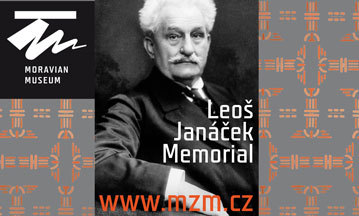Theme with variations
1. X. 1905 (Z ulica 1. October 1905), JW VIII/19
Remembrance, JW VIII/32
Along the Overgrown Path - Series 2, JW VIII/17
In the mists, JW VIII/22
The morning matinee in the composer's house will feature a piano recital by the excellent interpreter of Janáček's music, Jan Jiraský, on an authentic Ehrbar piano, which the composer received as a wedding gift and which accompanied him throughout his life. This unique instrument has recently been completely restored.
At the time of its creation, Janáček thought highly of the piano composition Thema con variazioni, or Zdenča's Variations, as he designated it opus number one, although he had written a number of other compositions before that. The creation of this composition dates back to the beginning of 1880, i.e. the period of the composer's studies at the conservatory in Leipzig. He composed the composition under the guidance of his professor Leo Grillo and dedicated it to his fiancee Zdenko Schulzová. It was an important work for the young Janáček, in which he tested his ability to compose in the style of Schumann, Tchaikovsky, Liszt, Brahms and Bach-Busoni.
Another composition is 1 October 1905 (Z ulice 1 October 1905). It is a work that was created spontaneously, as a reaction to the tragedy that took place during the demonstrations for the Czech University in Brno. Because Brno was predominantly German, the German representatives of the city were afraid of a greater influence of the Czechs and convened the so-called Volkstag on October 1, 1905, when German associations and organizations from a wide area were summoned to Brno to demonstrate their disapproval of the establishment of a Czech university in Brno. In response, the Czech residents of Brno also organized a large anti-German demonstration. Street fights took place between the two camps, to which the gendarmerie and subsequently the army were called. During one of the attacks, a young Czech worker, František Pavlík, was killed near Besední dom. Under the impression of this tragic event, Janáček originally wrote the three-movement composition Z ulice I. X. 1905. Just before the Brno premiere on January 27, 1906, however, he burned the last movement and after another performance in Prague even threw the entire autograph into the Vltava. Fortunately, the first performer of the piece, the pianist Ludmila Tučková, kept the original copy, which she drew attention to only in 1924. Thanks to this, this piano composition, forgotten by the composer and those around her for many years, has survived.
Memory is a short composition that Janáček composed in 1928 at the request of the Yugoslav composer and musicologist Miloj Milojević for the magazine Muzika. The author's compositional approach of the last, peak period is clearly visible on the floor plan of several bars.
The piano cycle of poetic compositions Po zarostlém chodníček was created successively in 1900, 1908 and 1911. The cycle was published in 1911 thanks to the Brno publisher Arnošt Píš. However, shortly before the publication, Janáček published the first composition from the "new" series of the series After an Overgrown Sidewalk in the fiction supplement of Večera Lidových noviny, but this time without a poetic title. Subsequently, he wrote two more compositions, the second of which is not finally resolved.
Janáček completed the piano cycle V mlhách in April 1912. Not long before, in 1910, he moved with his wife and housekeeper to a new house in the garden of the organ school and there, hidden from the world, with broken self-confidence and in a melancholic mood, he composed his last large-scale work for solo piano. He worked on it shortly after hearing the piano pieces of the French composer Claude Debussy, and it is no coincidence that his dreamy, melancholic work carries elements of musical impressionism. The cycle In the Mists won the first prize in the composition competition of the Friends of the Arts Club, which was to publish the winning work. However, Janáček left the possibility of publishing the composition in print to his pupil Jaroslav Kvapil, the second laureate of the competition. The cycle V mlhách was performed for the first time by Maria Dvořáková in Kroměříž on December 7, 1913.





